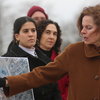Blendell wins state and national recognition
With passion and care, young musician documents the work of folk music collector
“How else can we, and our children's children, go back and learn where we came from and hear of the struggles of our forefathers, but for the work and endless labors of Alan Lomax? The little man's voice was heard because of Alan's efforts.”
Josh White Jr.
GUILDERLAND Brendan Blendell has listened to folk music for as long as he can remember.
“I listened to Woody Guthrie and Pete Seeger since I was a child,” said the 17-year-old this week. “I’ve always been interested in folk music.”
He plays it, too. Blendell started by playing the piano, and then added the trombone, the guitar, the banjo, the mandolin, and the bass. He’s currently learning to play the harmonica. He also composes music.
Blendell cares about the history of folk music and has made a series of documentaries, culminating in an award-winning short on one of the great field collectors of folk music.
Blendell’s documentary, Alan Lomax: Saga of a Folksong Hunter, won state and national recognition this year. Blendell’s 15-minute film won the 2009 Laura and Robert Chodos Award for Excellence in Student Research Using Historical Records, presented by the Board of Regents and the New York State Archives this fall.
The judges chose Blendell’s documentary from several hundred submissions, citing the way he “effectively integrates primary sources/music of the time with Lomax’s project to capture and document music and culture.”
An earlier 10-minute version of the film also won a prestigious award. One of 50 nationwide, Blendell’s documentary won the National Archives and Records Administration Student Research Award for New York State.
The son of psychologists Karl Blendell and Mary Murphy, Blendell has been honing his movie-making skills for years. He started in the eighth grade as a student at Farnsworth Middle School under the tutelage of Deb Escobar, making a film on Pete Seeger for New York State History Day.
The History Day theme that year was “Stand Up in History,” Blendell recalled. “Pete Seeger stood up for many different causes in his lifetime labor, civil rights, peace, the environment,” said Blendell who has met Seeger a couple of times. He’s proud that Seeger autographed both his banjo and his mandolin.
“He’s very passionate about what he stands for, even if people commit violent acts against him,” said Blendell.
Blendell transferred to The Doane Stuart School for ninth grade and continued his filmmaking, this time producing a documentary on Woody Guthrie for the History Day theme, “Triumph and Tragedy.”
“Woody Guthrie sang songs to the people of the Dust Bowl and the Great Depression,” said Blendell. “He wrote songs about the people for the people…He wrote 28 songs in 21 days about the Civilian Conservation Corps, building the Grand Coulee Dam. He wanted to inspire people, to let them know, ‘We’ll get through this Depression,’” said Blendell.
His third film, made his sophomore year at Doane Stuart, was on anti-war songs sung during the Vietnam War era. He focused on four songs “Alice’s Restaurant,” written by Woody Guthrie’s son, Arlo; Bob Dylan’s “Masters of War,” Seeger’s “Waist Deep in the Muddy Muddy,” and “Ohio” by Crosby, Stills, Nash & Young.
“Follow his lead”
In his junior year, when the History Day theme was “The Individual in History,” Blendell decided to focus on Alan Lomax. “He was an influential figure because he was passionate about collecting folk songs and preserving culture in general,” said Blendell. “Alan Lomax tried to say, ‘We need to preserve these songs…In the future, we’ll get sick of the commercial stuff and say, “Where is the good stuff? Where are our roots?” ’ ”
Using the Woody Guthrie Foundation; the Smithsonian Institute; the Library of Congress; and the Association for Cultural Equity at Hunter College in New York City, which Lomax founded, Blendell pieced together Lomax’s role as a folksong hunter.
“A lot of the material is available online,” he said. “If you go to the Library of Congress website and look at the section on American Memory, you can see the original documents and timelines,” he said.
The challenge became selecting the best material to fit his thesis. Working independently, Blendell would consult with Doane Stuart history teacher Drew Levy for advice on such things as his bibliography.
“I had to find out about Alan Lomax’s life first to pick what made him an important person,” said Blendell.
Alan Lomax, born in 1915, first worked with his father, John, a pioneering folklorist, recording American songs. Alan Lomax went on to collect music in Europe and the Caribbean, and also interviewed many of the music makers. He created what he called a “Global Jukebox,” a database of music from around the world.
Lomax broadcast radio shows in the United States and England that helped revive folk music in the 1940s and 1950s. In 1959, he put together a show at Carnegie Hall, the first time bluegrass and rock and roll were performed there, creating a controversy.
His later work, recording diverse music from different parts of the globe, helped lead to the World Music movement. When the Voyager spacecraft was launched in 1977, Lomax served as a consultant to Carl Sagan, creating a record to represent the music of the earth, which included not just Beethoven and Bach, but also jazz, blues, rock and roll, Navajo chants, Andean panpipes, and music from the Mbuti pygmies of Zaire.
The Lomax collection is now in the American Folklife Center at the Library of Congress, where both John and Alan Lomax had worked. “Throughout the world, folksong collectors tend to dig up old bones from one graveyard and put them into another graveyard their filing cabinets,” comments Pete Seeger on the Library of Congress website. “But Alan Lomax and his father, John, wanted the American people to once again sing the wonderful old songs of this country, which they never heard on the radio. So you who can read this should know where you can get them the American Folklife Center and they will live again.”
Deciding which old songs he wanted to keep alive to illustrate Lomax’s work was a hard choice for Blendell.
“I had hours and hours of music and videos,” said Blendell. “I had to decide how to fit what I wanted to say…I had to show that Alan Lomax was a significant person and suggest that we should follow his lead.”
Blendell is proud of the video techniques that he used. “I like to make my films as professional looking as I can,” he said. “My friends say that it looks like something on the History Channel.”
Music in the digital age
For the first time, his 10-minute History Day documentary on Lomax went beyond winning at the regional level and made it to the semi-finals at the state level, placing in the top six.
Blendell was delighted, then, when he got to add another five minutes for the New York State Archives competition. He interspersed clips of artists performing, and interviews with Lomax and Seeger, all with his narrative voice holding the documentary together.
While he was pleased to win the $100 award, Blendell said he didn’t do it for the money; in fact, he hadn’t realized there was a cash prize involved.
“I just entered because I like history,” he said, “and I’m really interested in music.”
He hopes to attend Oberlin College in Ohio next fall with the goal of getting two bachelor’s degrees in five years one from the College of Arts and Sciences and the other from the Oberlin Conservatory of Music.
Although he isn’t limiting himself to a single career path, Blendell is interested in both music and filmmaking. “I could see myself making documentaries or being a musician,” he said.
In documenting a documentarian, Blendell said, “I became more aware of how things happened in our past…Some types of music or language are dying out. I was like, ‘Wow, now I know why Alan Lomax was passionate about that.’ We need to document it and use it and learn from it.”
He went on, “I don‘t think we should meddle in a culture, but we should work to protect it.”
Blendell believes that Lomax’s recording of music and the artists who created that music has made a difference in the world today. “He was right. Commercialism is blocking out originality and creativity,” said Blendell. “A lot of independent music now incorporates world music,” the sorts of music that Lomax recorded.
“I think those old songs are surviving, but they’re changing, too,” said Blendell. “If you listen to blues artists like Muddy Waters, you can hear the suffering and the pain…That’s something you don’t come across often now…
“Folk music is taking a different direction. Take Bob Dylan; he’s still singing. He has pretty complex lyrics that portray different emotions.”
Blendell concluded, “There will always be a small pocket of people that appreciate the old things, the original things.” The digital age is spreading music in general over a much wider sphere, he said.
“A lot of young people today don’t know about culture in general or music in specific,” said Blendell. “Still, people in rural areas sing these songs that were recorded 70 years ago by Alan Lomax. The digital age will help us preserve them.”


